
Rösterei Maria-Rickenbach Morgenrot
250 g, Dark roast
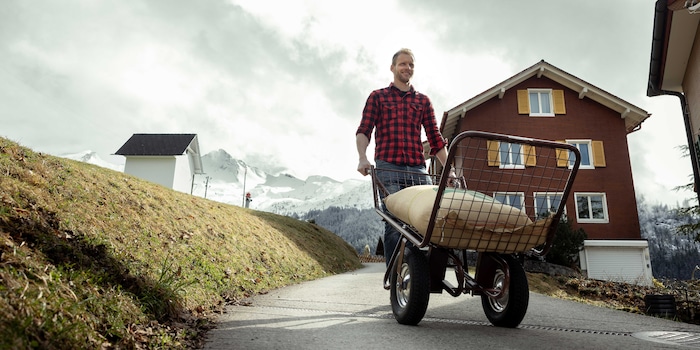
Maria-Rickenbach isn’t an obvious place to open a roastery. The easiest way to get to this small town in the heart of the canton of Nidwalden is by cable car. Without the locals’ goodwill, the start-up would have found things tough.
«Niederrickenbach station, request stop,» announces a tinny voice. Photographer Chris and I leave the regional train carriage alongside a kindergarten class. We change to the valley station of the cable car, where Andrija Stojkovic is waiting for us. He’s one of the three founders of the Maria-Rickenbach roastery. «Hello!» The operator of the cable car greets him with a firm handshake. «And congratulations!» Andrija recently became a father, and word’s got around. Everyone knows each other here.
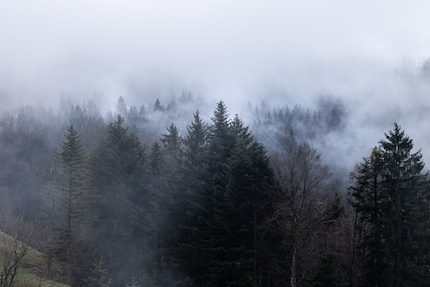
The gondola plunges into thick fog. «Now you know why we named our coffee blends after weather phenomena,» says Andrija, assuring us that the sun would soon break through. The roastery’s coffees are called Wetterleuchten (sheet lightning), Morgenrot (dawn), and Nebelmeer (sea of fog). How appropriate. It’s a few hundred metres from the mountain station to the roastery, past the Benedictine monastery and a small monastery shop. «Can you smell it yet?» asks Andrija. The unmistakable scent of freshly roasted coffee hangs in the air. The roastery is on the ground floor of a former hotel, and opposite, the Pilgerhaus restaurant (website in German) serves cordon bleu and Käseschnitten as well as coffee from its neighbour. «The heritage society keeps a close eye on things, which is why we had to install the chimney behind the house and were only allowed to put a small sign on the front.» All challenges that the start-up wasn’t initially expecting.
Stefan Wyrsch – part-time roast master and childhood friend of Andrija – welcomes us to the roastery. The front room is home to the 15-kilo roaster, imported from the Netherlands. There’s a large drum, which sits behind a round basin that cools the coffee beans as soon as they’ve finished roasting. In the back room, sacks of green coffee from countries like Ethiopia, Colombia and Guatemala are stacked. «I’ll make you a coffee in a minute! Let me just finish this batch quickly,» Stefan apologises. He checks the temperature on a screen and waits for the perfect time to finish roasting. The beans mustn’t be too dark, otherwise the coffee will be bitter. If they’re too light, the result will be too sour.
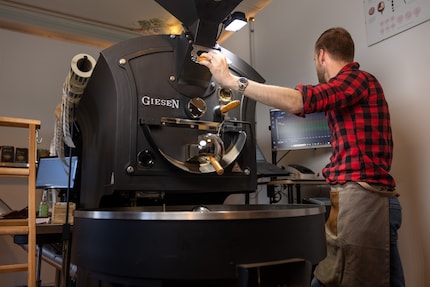
We start to hear cracking sounds inside the drum. This is a sign for Stefan that he now has to be particularly careful. The previously green, shrivelled beans are expanding due to the high heat and taking on more and more colour. At some point, the pressure is so great that they burst, almost like popcorn. Known as the first crack, this determines how light or dark the roast will be. It takes a matter of seconds. A quick lift of a lever and the roasted beans pour into the round cooling basin below like a waterfall.
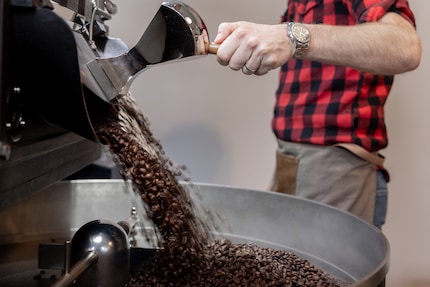
Stefan offers us an espresso from the lever-operated espresso machine. «My primary aim is to get the natural sweetness out of the beans. You don’t actually need any sugar for this espresso,» explains the roast master as he stirs them. It’s a trick that’s supposed to bring the flavours together. And it works: the espresso tastes balanced, with a natural sweetness. There’s even a hint of fruit coming through. «You’re right! That’s the Sidamo from Ethiopia,» confirms Stefan.
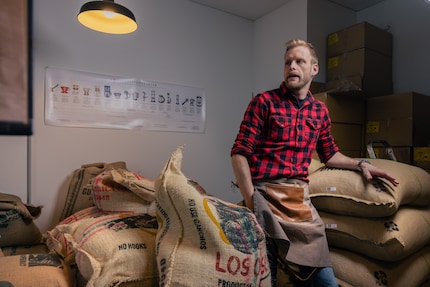
Since 2020, Stefan has been roasting every Friday in Niederrickenbach (the village’s secular name), but the pandemic and the site’s location made things difficult at first. The Dutch supplier was unable to send a technician to Switzerland, so the roaster had to be assembled with support via video call. Transporting it was an adventure in itself. The machine was too heavy and too big for the cable car, so a local forestry contractor had to transport it up the narrow road in an agricultural vehicle. In the mountains, people help each other. Luckily. The cable car delivers the sacks of green coffee, which weigh up to 70 kg. Stefan takes them the last 300 metres or so from the mountain station to the roastery with the sack trolley. The cable car employees know the process and sometimes store the sacks in the valley station until Stefan or Andrija can take them up.
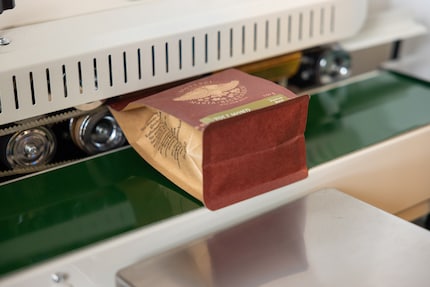
The roasted beans have now cooled down. Stefan has laboriously labelled the 250-gramme packs by hand and stamped the roasting date on them. Now he puts the small bags under the portioning machine and then has them sealed by a welding machine. «Investing in this process has paid off. Until recently, we did everything with a scoop, a pair of scales and a hand-held welding machine. It used to take ages!» laughs Andrija. The finished, portioned coffee bags are then either sent to customers (or Galaxus), sold in various village shops or placed in the honesty box fridge outside the door, where you can pay with TWINT.

Rösterei Maria-Rickenbach Morgenrot
250 g, Dark roast
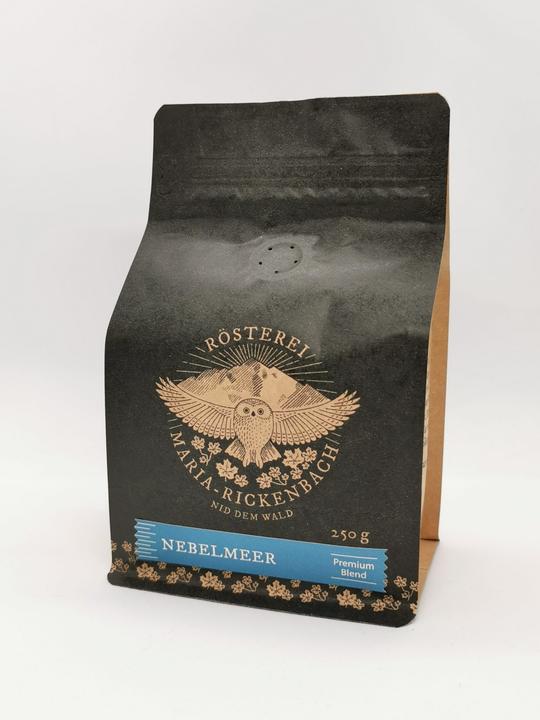
Rösterei Maria-Rickenbach Sea of Fog
250 g, Dark roast

Rösterei Maria-Rickenbach Weather lightning
250 g, Medium roast

Rösterei Maria-Rickenbach Morgenrot
250 g, Dark roast

Rösterei Maria-Rickenbach Sea of Fog
250 g, Dark roast

Rösterei Maria-Rickenbach Weather lightning
250 g, Medium roast
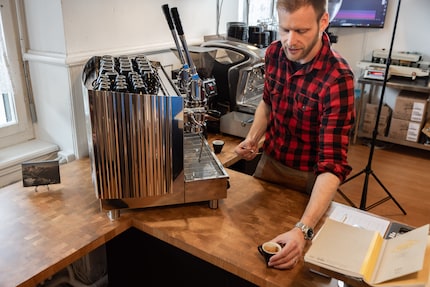
Bags are also sold in the roastery itself on Fridays when Stefan is roasting. «People are interested in what we do here and they like to pop in.» Many of them are surprised by how much attention to detail goes into it. For example, Stefan has already visited almost all of the coffee farmers. «Admittedly, I like to travel. But for us, it’s also part of the quality promise. This way, we can form our own opinion and talk to the people on site.» When Stefan then shows them pictures of the idyllic monastery town, the farmers in Colombia or Guatemala are excited and proud that their goods end up in such a picture-postcard setting.
Andrija, Stefan and the third member of the group, Mike Bacher, all still have their «day jobs» and mostly run the roastery in their free time. It’s not making anyone a living yet. Only roaster Stefan works part-time. «But we’re fully on track with our business plan,» reveals Andrija, who’s primarily responsible for the website and marketing. This means the part-time roasters have to be able to juggle work, family and the start-up, which isn’t always easy. So, we leave Stefan to do the next roasts in peace and say goodbye.
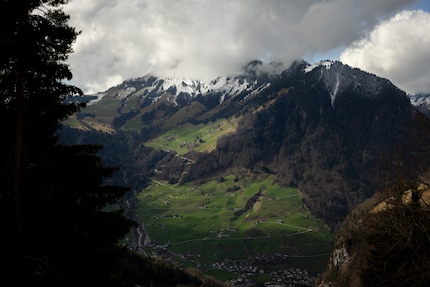
Andrija was right with his weather forecast. The sun’s now shining over the monastery, and more and more people are walking past. A family’s looking into the roastery with interest. «Would you like to take a look inside?» asks Stefan and waves to us before we take the cable car down. «See you next week,» the cable car employee says goodbye, probably just to Andrija. But somehow, we’re already a small part of the family…
When I flew the family nest over 15 years ago, I suddenly had to cook for myself. But it wasn’t long until this necessity became a virtue. Today, rattling those pots and pans is a fundamental part of my life. I’m a true foodie and devour everything from junk food to star-awarded cuisine. Literally. I eat way too fast.
Interesting facts about products, behind-the-scenes looks at manufacturers and deep-dives on interesting people.
Show all